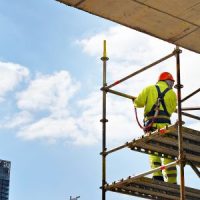Common Causes of Scaffolding Accidents

A scaffold is a crucial structure in the construction industry. Scaffolds are those temporary structures at construction sites that elevate and support construction workers and materials. A scaffold helps construction workers reach areas they would otherwise not be able to reach. It is estimated that millions of workers in the construction industry work on scaffolds. Unfortunately, with the use of scaffolds comes a risk. Scaffolding accidents are not rare occurrences. According to the Bureau of Labor Statistics, scaffold accidents cause 4,500 injuries and 60 deaths annually. By understanding the causes of scaffolding accidents, employers and workers can be better equipped to prevent these accidents. This article discusses some of the common causes of scaffolding accidents and what you should do after a scaffolding accident.
Common Causes of Scaffolding Accidents
Several issues can lead to scaffolding accidents on a construction site. Some of the scaffolding accidents that can occur at a construction include falls and being struck by falling objects. When it comes to the causes of scaffolding accidents, the following are some of the most common:
Scaffolding Defects
One of the most common causes of scaffolding accidents is scaffolding defects. For example, an accident can happen if scaffolding lacks necessary bracing or the steel tubing is compromised. If a scaffolding defect causes an accident that results in severe injuries, on top of filing a workers’ compensation claim, the injured worker can file a product liability claim against the company that designed or manufactured the scaffolding.
Improper Installation
If scaffolding is not installed correctly, accidents can happen. It is crucial to follow the manufacturer’s guidelines when installing scaffolding. Ignoring guidelines or taking shortcuts can have disastrous results.
Failure To Maintain Scaffolding Adequately
For scaffolding to maintain its structural integrity, regular and proper maintenance is necessary. Scaffolds wear down over time due to continuous exposure to the elements and daily use. Damaged scaffold parts need to be replaced, and old and worn-out scaffolds need to be replaced. Accidents can happen if scaffolding is not maintained regularly and properly and old scaffolding is not replaced.
Inadequate Worker Training
Worker training is crucial in ensuring safety. Workers not trained in scaffolding assembly, disassembly, or usage are more likely to face accidents. Workers who are not well-trained are at a greater risk of making errors, resulting in avoidable accidents.
Natural Elements
Scaffolding accidents can also happen due to unpredictable weather. Storms, winds, and sudden downpours can put construction workers at risk.
Failure To Protect Workers From Falling Objects
When working on scaffolds, workers can suffer injuries if an object falls from overhead and hits them. If there are objects overhead, scaffolding should be covered to protect workers.
What Should You Do After a Scaffolding Accident?
After a scaffolding accident, it is crucial that you notify your employer about the accident as soon as possible, seek medical attention, and speak to a qualified workers’ compensation attorney. After you are injured in a scaffolding accident, you may be eligible to recover workers’ compensation benefits. An attorney can help you determine your eligibility for workers’ compensation and file your claim.
Contact a Vermont Workers’ Compensation Attorney
To speak to our Vermont workers’ compensation attorneys at Sluka Law PLC, call 802-457-1000 or fill out our online contact form.
